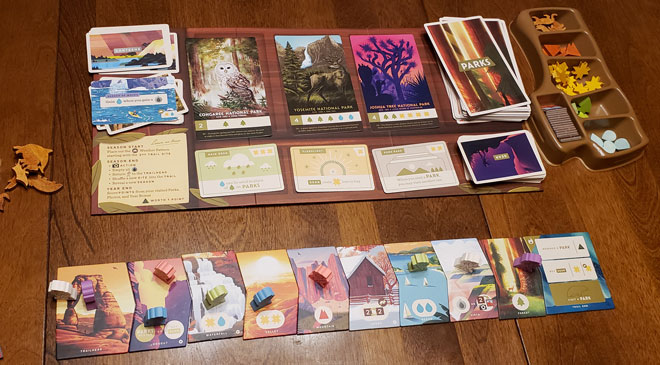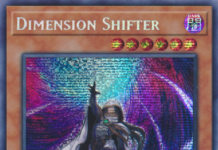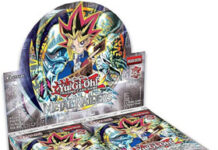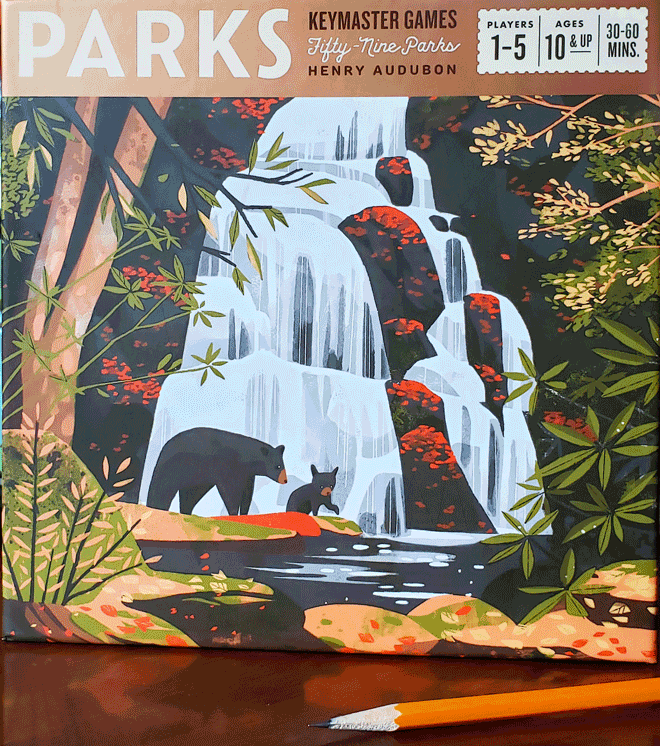
Parks is an artful new board game designed by Henry Audubon and published by Keymaster Games. I saw this at GenCon and purchased it purely because of the very appealing art depicting America’s national parks. It just so happens that it’s actually an excellent board game, made only better if you are one with an interest in the nation’s parks. It’s for 1-5 players who each act as hikers making their way along a seasonal nature trail. The goal is to have the most points at the end of four seasons, gained by visiting parks, taking photos and meeting a personal goal. I highly recommend this game as an addition to any board game collection.
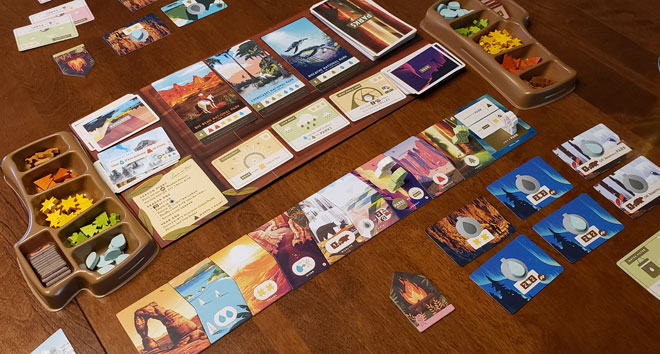
What’s in the box?
The box contains:
- A board for laying out cards representing parks to visit, along with canteens and other gear
- 48 Park cards, depicting our national parks
- 10 tiles, along with a trailhead tile and a trail end tiles that are used to make unique trails for each season of play
- Season cards, Year cards, Gear cards, Canteen cards and Event cards
- Tokens representing forest, mountains, sun, rain/water and wildlife, along with 2 trays for holding the tokens for play and storage
- Hikers (2 per player) and a first hiker token
- Campfire tiles (1 per player)
- Camera piece, and 24 photo pieces (1 point each).
- 12-page Rules booklet
Here is a look at the brilliant nested-box-design for the contents:
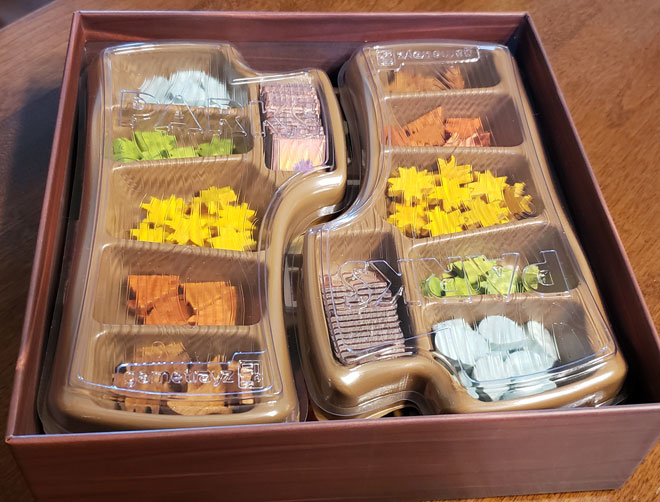
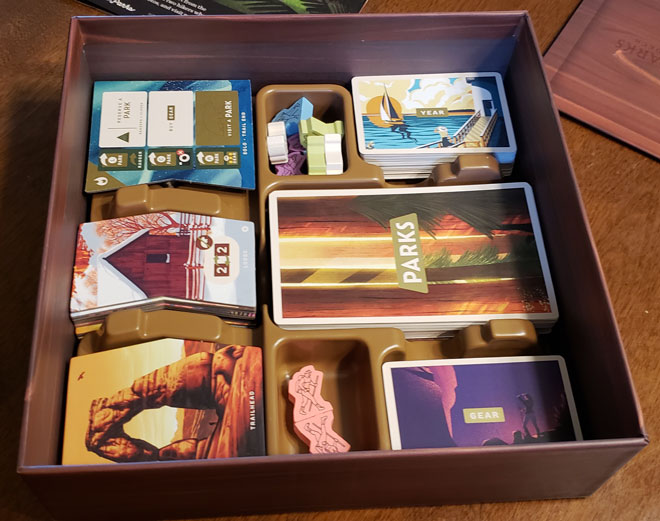
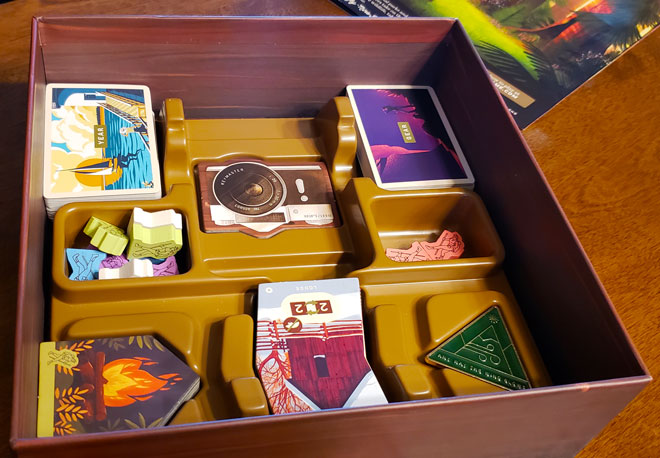
How do you play Parks?
Parks is played with 1 to 5 players. It’s great to see the option to play solo, but I’ll describe the play for 2+ players first. Please note: This is rudimentary discussion on the how the game plays. There is a great tutorial / playthrough on the KeyMaster Games website that does a great job of teaching the game. We highly recommend watching their video if you would like more details.
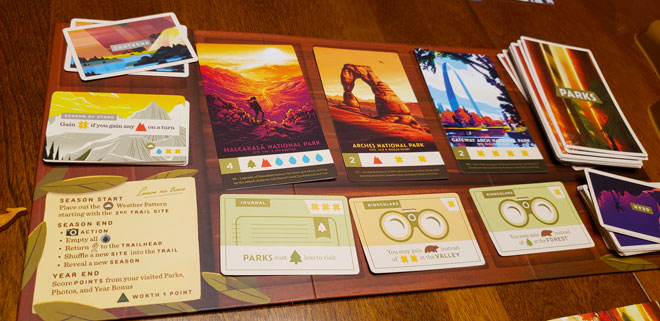
Set-up includes selection of the first Season card (with a special feature and weather pattern that affects gameplay for that round) and creating an initial trail. The first set of Park cards to visit is revealed. Each park has a set of requirements that must be filled in order for a hiker to visit – various combinations of forest, mountains, sun and water tokens. Each park has a point value ranging from 2 to 5.
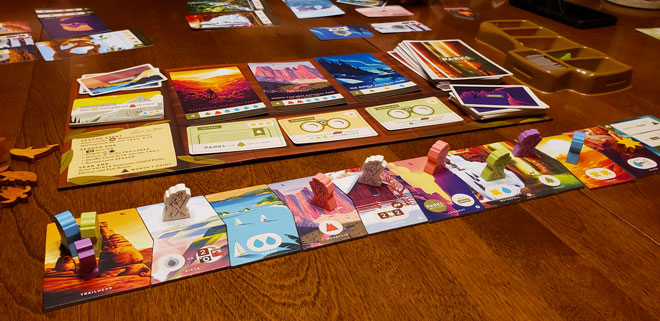
Each player’s turn consists of moving one of their two hikers along the trail to a site/tile of their choice and performing the action called for on that site. Basic actions include collecting forest, mountain, sun and water tokens that will be used to visit parks. There are also special actions that allow for buying canteens or gear, taking photos, switching tokens, reserving parks, and visiting parks.
Some of the fun actions that cards let you take:
- Canteens let you convert water tokens into other resources
- The Camera lets you take photos of places you’ve visited. The photos are points at the end of the game.
- Campfires are used to allow your hiker to share a site occupied by another hiker, but then the campfire is extinguished. You can’t use a campfire again until your hiker has reached the Trail End.
- Gear gives you ongoing abilities – useful at Trail Sites and when visiting Parks.
There is some strategy in navigating the trail sites to get the desired mix of tokens you want. And you can’t visit a site with another hiker already there unless you decide to build a Campfire. Using canteens and other gear can make it easier to visit parks and earn points. After any park is reserved or visited, a new Park card comes out – so that there are always three parks available for all players.
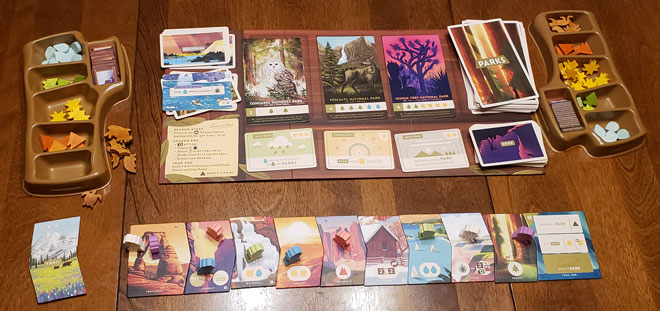
A season is complete when all the hikers have reached the trail end, which is the last opportunity to reserve a park, or to turn tokens in for an actual visit to a park. The player with the camera gets a chance to take a photo.
Then the hikers are returned to the trailhead and a new trail is created with one additional tile added in for each new season, with all tiles randomly laid out. A new Season card is revealed and play begins again.
The game is complete when the players have taken their hikers through four seasons. Each player counts up the points on each of their Park cards and adds in the number of photos they may have taken. They also add in any points they may have earned because of attaining a personal goal, as outlined on their chosen Year card.
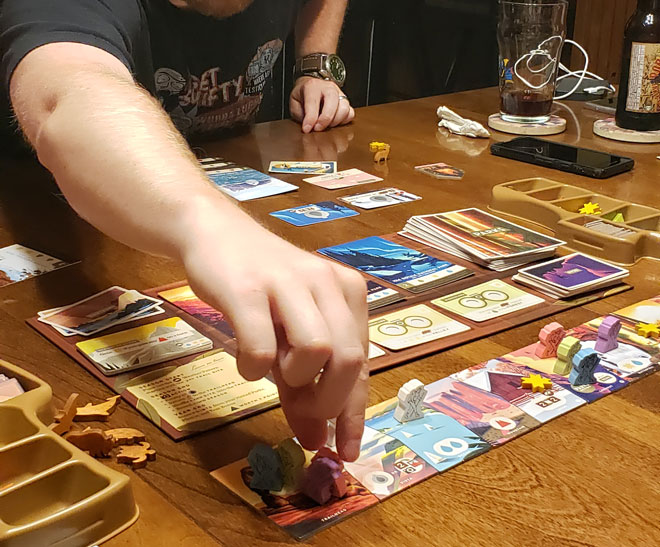
The solo game plays very similarly except that the two hikers are trekking alongside park rangers taking care of the trail, each taking their separate turns. The Event cards are used exclusively for solo play, with events triggered by rangers’ sun and rain/water collections. A solo player would be considered to have done well with 25 or more points at the end of the four seasons.
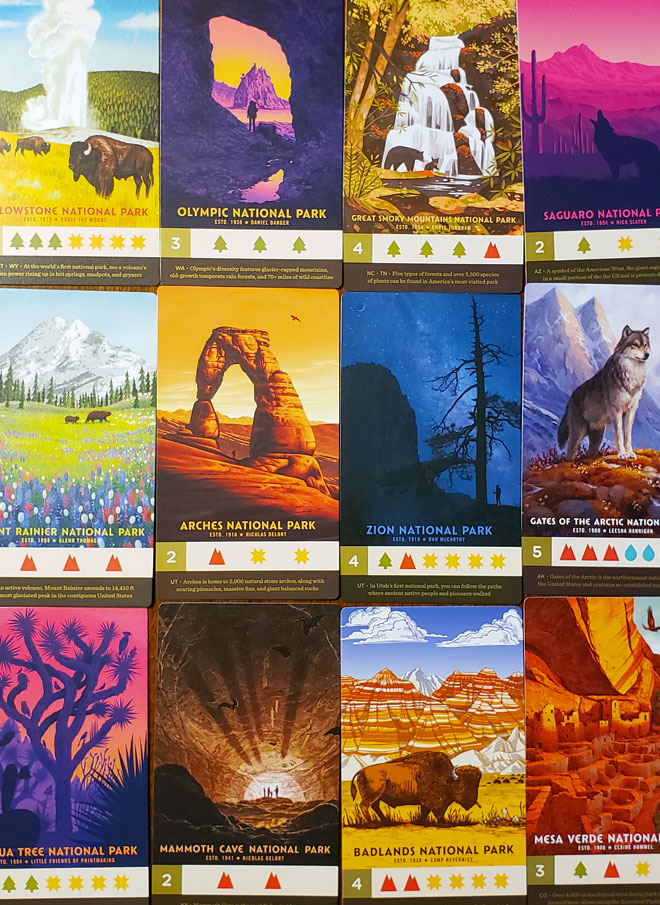
Critique:
- Artistry – The artwork is very pleasing, with the Park cards coming from the Fifty-Nine Parks Print Series, a collection created by a mix of very talented artists.
- Tokens/Token Tray – The tokens are well-made stained wood pieces, with the 12 wildlife tokens each a unique creature – think bear, deer, turtle, bat, etc. Adorable! And there are two trays to hold the tokens – put on each side of the gameboard, no player has to reach very far.
- Easy to Learn – This is a moderately easy game to learn and to teach to others. It’s listed as being suitable for ages 10+ and that feels right.
- Good Rulebook– The rulebook is easy to read and has plenty of explanatory pictures, all of which are artfully done.
- Quick Engaging Play– Each player’s turn is fairly quick as there’s not a multitude of possible moves to consider. The game plays in 30 minutes or less for 2 players who have gotten past the learning game stage. Five player games may take up to an hour for those familiar with the game.
- Strategy Needed for the Win – While this is not a complex game, there are many approaches to winning, with clever use of canteens and gear and the camera all coming into play. I haven’t figured out the best ways to win yet, but I know it’s not just wandering along the trails without thought.
- Different Every Time – Each game can be unique since the trail has a randomly assigned order of trail sites each turn and an additional random trail site added in each subsequent season. Also, different Canteens, Items, Seasons and Parks will show up every game.
- Great Box Design– The box’s artwork rivals that of the Park cards, and it is exceptionally well-designed to hold all the components in an orderly layered approach.
- NPS Donation – The National Park Service gets a donation with each game purchased, according to the back of the box.
- Some National Parks are Missing – Only 45 of the 61 national parks show up in the Park deck. I’d love to see all the parks I’ve been to, and all those I still plan to visit. Maybe those other parks will be introduced in a future expansion, along with National Monuments.
- Game Board Doesn’t Lie Flat – Not a big deal because a game could be played without it.
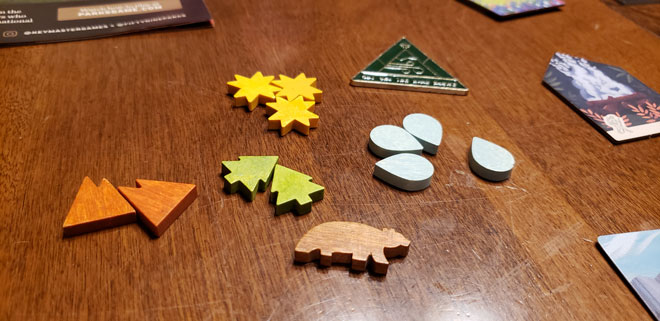
Final Thoughts
All in all, the positives far outweigh the minor disappointments. It’s a very easy call to recommend this game as everyone who’s played it with me has been a fan. It’s another one of those family-friendly uplifting games that you can have fun playing whether you win or lose, and it’s a nice alternative to sci-fi and fantasy-based games. The parks are all real places you can go to and may have already visited. This is a game people can really connect with, and I’m happy to have it in my collection.
